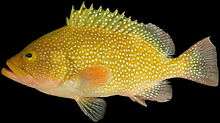Calico grouper
| Calico grouper | |
|---|---|
 | |
| Scientific classification | |
| Kingdom: | Animalia |
| Phylum: | Chordata |
| Class: | Actinopterygii |
| Order: | Perciformes |
| Family: | Serranidae |
| Genus: | Epinephelus |
| Species: | E. drummondhayi |
| Binomial name | |
| Epinephelus drummondhayi Goode & Bean, 1878 | |
Epinephelus drummondhayi is a species of fish in the family Serranidae. It is commonly called the calico grouper, kitty mitchell, speckled hind, or strawberry grouper. It is found in Bermuda and the United States. Its natural habitats are open seas, shallow seas, subtidal aquatic beds, and coral reefs. It is threatened by habitat loss.
The speckled hind is a U.S. National Marine Fisheries Service Species of Concern. Species of Concern are those species about which the U.S. Government’s National Oceanic and Atmospheric Administration, National Marine Fisheries Service, has some concerns regarding status and threats, but for which insufficient information is available to indicate a need to list the species under the U.S. Endangered Species Act (ESA).
Species Description
Speckled hind derive their name from the multitude of tiny white spots that cover their reddish-brown head, body and fins. Juvenile specimens tend to have yellow body color with white spots (Ross 1988). Speckled hinds are deep-water groupers: adults inhabit offshore rocky bottoms in depths of 80 to 1300 feet (25 to 400 m) but are most common between 200 and 400 feet (60 and 120 m) in many areas of the Western Atlantic.
Ecology
There is a paucity of data for this species: the stock structure is not characterized, population size is unknown and much of their life history has not been thoroughly investigated.
Conservation
Speckled hind are caught as bycatch from the deepwater snapper/grouper fisheries off the coast of North Carolina through Texas and directly in recreational fisheries by hook and line mostly (SAFMC 2005).
Conservation Designations
U.S. National Marine Fisheries Service: Species of Concern
American Fisheries Society: Endangered
Status Reviews
None
References
NMFS. Species of Concern Fact Sheet . 2008
Sources
- Ng Wai Chuen & Huntsman, G. 2006. Epinephelus drummondhayi. 2006 IUCN Red List of Threatened Species. Downloaded on 4 August 2007.
- U.S. National Marine Fisheries Service Species of Concern program
